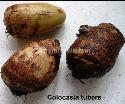Arvi Or Colocasia Chips With Flour or Tapioca/Sago Coating
Tali Arvi with Atta or Sabuana Coating
Sunita Gupta
Colocasia is also known as taro or elephants ear, or Colocasia esculenta around the world.
Colocasia esculenta probably originated in India, where it is generally known as Arvi. Its tubers/corm look like small yams, with brown rings, dark and light alternating, all along its fibrous surface. They have a white, cream or light pink flesh. The tubers are used to make chips, soup, numerous varieties of curries and bhajies, roasted like potatoes, even made into flour. It is a staple food in many tropical countries around the world, it is an excellent source of fibre, vitamins C and E, potassium, magnesium, and folic acid. Colocasia leaves of the Indian variety are edible but they must be boiled before eating, in order to remove the oxalates that cause irritation of the tongue. See Colocasia Leaf Rolls, delicious! There are many varieties of Colocasia around the world; eddo, dasheen, elephant's ear, West Indian kale, coco-yam, old coco-yam and coco. Some varieties contain oxalates even in their tubers, and can cause irritation of the skin and tongue and should be avoided.
Serves 4
Ingredients
500 gm. Colocasia tubers
3/4 tsp. salt
1/2 tsp. chilli powder
1/2 tsp. amchoor or dry mango powder or juice of half a lemon
1/2 tsp. salt
For the coating
2 tbsp.-1/4 cup chapatti or whole wheat flour or fine sago/tapioca* pearls (sabudana) or besan (gram flour)
1/2 tsp. carom seeds or ajwain
Salt to taste
For frying
Oil for deep frying
Instructions
Mix flour or sago pearls with salt and carom seeds, keep aside in a flat plate.
Boil Colocasia tubers in their skin. I cook them in a microwave steamer on full (800) for 10 minutes.
Cool and peel.
Slice each tuber into half lengthways. Or, you can flatten each tuber between your palms.
Heat oil in a wok or karahi.
Place Colocasia slices in a bowl, sprinkle salt, chilli powder and amchoor (mango powder) or lemon juice and stir to coat on all sides.
Just before frying, add the seasoned flour and mix to coat all tubers. If using tapioca pearls, press gently with greased hands to make the coating stick to the Colocasia slices. You may need to moisten the colocasia slices before rolling in tapioca, so it sticks.
Deep fry until golden brown and crisp. Drain on an absorbent paper.
Serve immediately, hot and crisp with Tomato Ketchup or Green Mango Chutney or chilli sauce of choice.
Notes
*Sago and tapioca pearls look the same and can be used interchangeably. Tapioca is made from the starch of the roots of cassava tree. Sago is made from the pith from the stem of the sago palm tree.







